The Jay I. Kislak Collection
For the items in the categories below, a basic
description and links are provided.
- The Page turner link allows you to move through the item, page by page;
page images may also be enlarged.
- If there is a PDF link, you will need the freely
available Acrobat viewer. This will allow you to view the material,
and print it in its entirety.
- Please make note of commentary made available in attachments or bookmarks in many of the PDF links.
- If there is a Page by Page Flash presentation, you will need the freely
available Flash
Player.
- The bibliographic information link will query the Library's online catalog
and display the catalog record for the item.
|
Kislak 213
Cortés, Hernán, 1485-1547. Hernán Cortés Power of Attorney, 1526.
Fearing the power that the conqueror had amassed, the Spanish Hapsburg king, Charles V, sent a residencia [judge] to investigate Cortés. In this letter, Cortés somewhat arrogantly proclaims “I cannot attend the hearing,” and he appoints three deputies to act as his agents. Herein he gives them full powers of attorney. The man Charles chose was a young and inexperienced judge, Licentiate Ponce de León (not directly related to the famous explorer of Florida). Licentiate Ponce de León died under very mysterious circumstances shortly after arriving in Mexico and within a fortnight of the signing of this document.
Page Turner - PDF (1.11 MB) - Bibliographic
Information |
Works by Bartolomé de las Casas
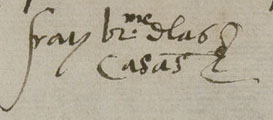
Kislak 244. Statement of Opinion, 1543.
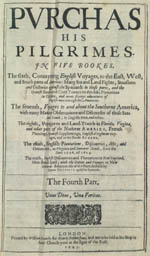
Kraus Collection of Sir Francis Drake. Haklvytvs posthumus, or, Pvrchas his Pilgrimes, 1625.
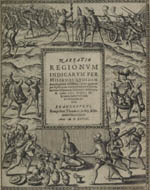
Kislak 250.
Narratio Regionum Indicarum per Hispanos Quosdam Deuastatarum Verissima, 1598.

Kislak 253.
Le miroir de la cruelle, & horrible tyrannie espagnole perpetree au Pays Bas. Amsterdam: Ian Evertss, 1620.
|
Las Casas was born in Seville, probably in 1484, and immigrated to Hispaniola with his father in 1502. He returned to Europe in 1507 and traveled to Rome where he was ordained a deacon. After a religious experience in 1514, las Casas returned his serfs to the governor and began his lifelong struggle on behalf of the Indigenous peoples of the Indies.
In 1520 Las Casas gained royal support for a plan to build a colony of farm communities inhabited by both Spanish and free Indians in present-day Venezuela. The experiment failed after a year of opposition of the local encomenderos [Spanish trustees of indigenous people] who incited Indian attacks on the settlement. Las Casa returned to Santo Domingo and joined the Dominicans. He concentrated on developing his philosophy and writing his account of the history of the Indies.
He made several trips back to Spain where he argued that that the principal end of Spanish presence and settlement in the New World was the conversion of the Indigenous to Christianity and continued to condemn abuses.
In 1542, las Casas convinced Charles I to sign the "New Laws of the Indies" which prohibited Indian slavery and attempted to put an end to the endomienda system. In 1544 he was named bishop of Chiapas in Guatemala but his radical ideas met great resistance and the “New Laws” were widely ignored.
In 1547 las Casas returned to Spain where he spent the remainder of his life. Las Casas continued condemning injustices, proposing reforms, and advocating peaceful evangelization methods.
At his death in 1566 las Casas left two massive historical manuscripts, Historia de las Indias and Historia Apologetica that remained unpublished until 1875 and 1876.
_____________________________________________________________________
Kislak 244
Bartolomé de las Casa Statement of Opinion, 1528.
Page Turner - PDF (2.18 MB) - Bibliographic
Information
In 2007 Kislak Fellow, Fr. David Orique from the University of Oregon, spent four months at the Library of Congress studying this las Casas manuscript originally thought to have been written in 1528. Fr. Orique planned to research Las Casas' epistemological development by comparing this document in the Kislak Collection with other Las Casas' writings from 1516. Orique's research indicates, however, that the letter was actually written in 1543. You can read his analysis and also his translation of the document by clicking the PDF.
Purchas, Samuel, 1577?-1626. Haklvytvs posthumus, or, Pvrchas his Pilgrimes. London, Imprinted for H. Fetherston, 1625.
Page Turner - Bibliographic Information
In his book, Brevísima relación de la destrucción de las Indias (A Short Account of the Destruction of the Indies), Bartolomé de las Casas condemned the abuses of the Indians during the first decades of Spanish colonization of the New World. At this time European attention seems to have been drawn to Spanish America and Spain's treatment of the Indians. Las Casas was keenly aware of the power of the printed word, so much so that he ignored the need to secure royal permissions before publishing the treatises. They exploded onto the European scene, were widely translated and frequently reissued, especially in anti-Spanish contexts. A Dutch translation in 1578 was followed by Flemish, French, Latin, German and English editions, all printed before 1600:
Seer cort Verhael vande destructie van d'Indien. Antwerp, 1578.
Spieghel der Spaenscher tirannije, waer inne verhaelt worden. Brussels, 1578.
Tirannies et Cruautez des Espagnols. Antwerp, 1579.
Histoire admirable des horribles insolences... París, 1582.
The Spanish Colonie, or Briefe Chronicle of the Acts... London, 1583.
Newe Welt. Warfafftige Anzeingung Der Hispanier... n. p., 1597.
Narratio regionum indicarum per Hispanos quosdam devastatarum verissima, Sumptibus. Frankfurt, 1598.
Warhafftiger und gruendtlicher Berich Der Hispanier. Frankfurt, 1599.
Kislak 250
Casas, Bartolomé de las. Narratio Regionum Indicarum per Hispanos Quosdam Deuastatarum Verissima. Francofurti: Sumptibus Theodori de Bry, & Ioannis Saurii typis, anno 1598.
Page Turner - PDF (64.17 MB) - Bibliographic
Information
This version, with its extraordinary graphic images was published by Theodore de Bry in 1598 as one of his continuing series of books on the Americas, which also included the monumental “Grande Voyages” series of books.
Kislak 253
Casas, Bartolomé de las. Le miroir de la cruelle, & horrible tyrannie espagnole perpetree au Pays Bas. Amsterdam: Ian Evertss. Cloppenburg, 1620.
Different reasons motivated the printing of non-Spanish editions of las Casas’s treatises that were published in Seville in 1552 and 1553 [See the commentary that accompanies Narratio Regionum.] In the Netherlands the treatises were used to strengthen patriotic-revolutionary unity during their long struggle for liberation from Spain. Between 1578 and 1670, the Brevísima relación, individually or in combination with other las Casas treatises was published twenty-seven times. These publications were used predominantly for propaganda purposes. Gradually, however, Dutch colonial motivation subtly emerged. An example of this admixture of purposes is found in the 1620 French edition of the Brevísima relación published by Jan Evertszoon Cloppenburg in Amsterdam. The theme of national independence and, to some extent, of religious freedom was dominant in this abridged edition.
Page Turner - Bibliographic
Information |
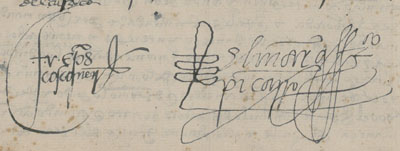 |
Kislak Catalog #239
Francisco Pizarro Response to a Petition by Pedro del Barco, 1539 Apr. 14.
Pedro del Barco petition (on the verso) requests inspections of encomiendas before instituting reforms regarding repartimientos. Pizarro's response is counter-signed by Fray Vicente de Valverde, Bishop of Cuzco.
Extremely rare rubric signature of Pizarro; signed "El Marques Pizarro.”
Page Turner - PDF (2.18 MB) - Bibliographic
Information
|
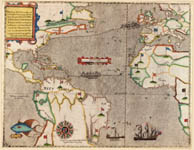
Route of Drake's Voyage

Santo Domingo (Dominican Republic)
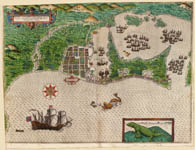
Cartagena (Colombia)
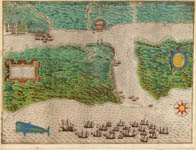
St. Augustine, Florida
|
Kislak Catalog #279
Boazio, Baptista. [Map and views illustrating Sir Francis Drake’s West Indian voyage, 1585-6]. [London?: s.n., 1589]
Page Turner - PDF (2.16 MB) - Bibliographic
Information
Map and views created to illustrate Bigges' and Croftes' Summarie and true discourse of Sir Frances Drake's West Indian voyage… With geographicall mappes exactly describing each of the townes ... made by Baptista Boazio. London: Richard Field,1589.
One map and four bird’s-eye views, all hand colored. The caption on the voyage map is in English. The city view captions are in Latin.
During the Anglo–Spanish War (1585–1604), an intermittent conflict between Spain and England that was never formally declared, Sir Francis Drake sailed for the West Indies and sacked Santiago in the Cape Verde Islands, Santo Domingo, Cartagena, and San Agustín in Florida. Baptista Boazio, an Italian artist resident in London, made engravings of the attacks. He may have obtained drawings from a participant, perhaps from Drake himself. The first engraving is a map of Drake's voyage showing Europe, western Africa, northern South America, and eastern North America. The four other engravings consist of bird's-eye battle plan views of the cities of Santiago, Santo Domingo, Cartagena, and St. Augustine, Florida. The views are illustrated in great detail, showing the fleet of 23 ships, as well as land battle plans of the English attacks on Spanish harbor forts. Animals, flags, crests and compasses decorate the cartography.
The Boazio engravings are historically important for understanding the activities of Sir Francis Drake's (1540?-1598) and also because the four city plans represent the first printed view of each locality.
Drake then sailed to Roanoke Island, off the Virginia coast, to evacuate the survivors of the failed English colony. The plan includes an illustration of a dolphin that Boazio very likely copied from the drawings of John White. John White and the scientist Thomas Harriot were part of a scientific expedition sent gather information about the New World for the English. They visited Indian villages and mapped the area as far north as the Chesapeake Bay.
For additional information please refer to Sir Francis Drake: A Pictorial Biography by Hans P. Kraus online at: http://www.loc.gov/rr/rarebook/catalog/drake/drake-6-caribraid.html.
Santiago, Cape Verde
Drake’s fleet left Plymouth on September 14, 1585, sailing first down the Spanish coast to Bayonne and Vigo and on to the town of Santiago in the Cape Verde Islands off the coast of West Africa. On November 17th Drake looted and burned the town before crossing the Atlantic.
Santo Domingo (Dominican Republic)
On New Year’s Day 1586 Drake reached Santo Domingo on Hispaniola Island (present-day Haiti and the Dominican Republic). He captured and plundered the town then demanded, and received, a ransom of 25,000 ducats. This image shows the English fleet in the bay, and the infantry battalions attacking the town.
Cartagena (Colombia)
The fleet sailed to Cartagena; situated on the South American coast of Colombia, and captured the town of February 9th. Drake demanded, and received, a ransom of 110,000 ducats. This view of Cartagena depicts the English infantry marching on the city. The fleet remained on the coast for six weeks of repair before sailing around Cuba, through the Florida Straits, and on to St. Augustine.
St. Augustine, Florida
The view of St. Augustine is the earliest engraving of any locality that is now in the United States. The English fleet lies at anchor, the infantry troops having disembarked and are attacking the Spanish settlement on May 28 and 29, 1586. |
 |
Kislak 423
Philip II, King of Spain, 1527-1598. King Philip II Grant of Arms, 1566 Nov. 25.
Grant of arms conferring nobility on Alonso de Mesa and Hernando de Mesa in recognition of their service to the Crown. Signed "Yo el Rey." November 25, 1566. One page accompanied by nineteen pages of text with endorsements. The illuminations are multi-colored with gilt depicting a Madonna and child, cornucopia, bird, butterfly, flowers, cherubs, and mounted knight in-arms with sword and herald. The origin of the heraldic tradition in Spain, including inheritable coats of arms, began in the eleventh century as a means to distinguish nobles on the field of battle. Spanish nobility was based almost entirely on military service. The "Coat" of Arms actually began as a cape or coat that was worn over armor. The design of the arms were up to the owner and could be inherited through either males or females.
Page Turner - PDF (10.36 MB) - Bibliographic
Information |
|
Kislak 839
Menéndez de Avilés, Pedro, 1519-1574. Pedro Menéndez de Avilés sailing order, 1572 July 3.
In the age of piracy on the high seas, sailing instructions were top-secret documents upon which rested the security of the king's fleet and his treasure. Here, Menéndez de Avilés, first governor of Spanish Florida, gives Don Cristóbal de Eraso complicated and detailed instructions for sailing to Spain on the Buenaventura with his fleet, via the islands of Flores and San Miguel. He is admonished not to proceed beyond a designated rendezvous without further instructions from Menéndez “under penalty of paying with his person and his property for any injury to his Majesty or his royal treasury.” With notary's signed statement of delivery to Eraso on 21 July 1572.
Page Turner - PDF (569.11 KB) - Bibliographic
Information |
|
Kislak 461
Philip II, King of Spain, 1527-1598. Philip II letter, 1578 Dec. 2.
Philip II complains to the Archbishop of México City about his practice of appointing monolingual priests to Indian benefices. Philip had previously ordered the archbishop not to appoint clergy unskilled in Indian tongues. Despite the king's command, the archbishop had still allowed many monolingual priests to hold Indian benefices. At best, these ill-prepared priests had memorized formulae and phrases from standard works, but they were in no way bilingual. The king orders this and similar practices to halt so that the genuine conversion and the reformation of the Indians can occur. Counter-signed by the King's secretary, Antonio de Eraso.
Page Turner - PDF (397.57 KB) - Bibliographic
Information |
|
Kislak 346
Linschoten, Jan Huygen van, 1563-1611.
[Itinerario, Voyage Ofte Schipvaert van Jan Huygen van Linschoten naer Oost ofte Portugaels Indien. English]
Iohn Huighen van Linschoten his Discourse of voyages. London: Iohn Wolfe, [1598].
Translated from the Dutch by William Phillip.
The original Dutch edition of Linschoten’s Discourse appeared 1595-1596 and it is undoubtedly one of the most important travel books ever published. Until its publication, no other work contained so much usable intelligence on the East and West Indies. Unhindered by censorship, Linschoten was able to include precise sailing directions and physical descriptions, travel accounts culled from contemporary Portuguese, Spanish and Dutch sources as well as information on commerce and trade. The book was so popular that it was given to each ship sailing from Holland to India. This is the first English edition.
Page Turner - PDF (440.20 MB) - Bibliographic
Information |
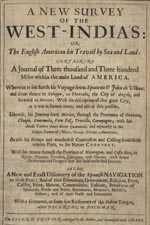 |
Kislak 355
Gage, Thomas, 1603?-1656. A New Survey of the West-India's … The Second Edition Enlarged by the Author, and Beautified with Maps. London: E. Cotes, 1655.
Thomas Gage, an Irishman, spent over a decade in Central America. As a child Gage was sent to Spain to study with the Jesuits. He joined the Dominican order instead, and in 1625 began his travels in Mexico, Guatemala, Nicaragua and Panama in violation of the Spanish royal decree excluding foreigners from the new Spanish territories. Gage spent most of the next 12 years living among the Indians and occasionally serving as parish priest or professor of philosophy. He grew tired of the New World, escaped, returned to England and wrote this book based entirely on his own observations. It contains a full account of his travels and rich details of Central American geography and peoples. Gage deplores the cruelties of Spanish rule and exhorts the English crown to invade and seize the Spanish territories. The book caused an immediate sensation for its revelations of the wealth and defenselessness of the Spanish American colonies. He abandoned the Catholic Church and eventually became a priest of the Church of England and married. He apparently settled in Jamaica in 1656 shortly after the English conquest of that island from the Spanish.
Page Turner - Bibliographic
Information
|
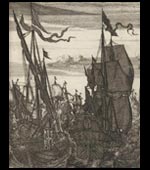 |
Kislak 843
Exquemelin, A. O. (Alexandre Olivier). The
Buccaneers.
t'Amsterdam. By Jan ten Hoorn, Boeckverkoper ..., anno 1678.
This is the first edition, in Dutch, of one of the most important books
about pirates ever written. Alexandre Exquemelin, a native of Harfleur,
went to the Caribbean in 1666 with the French West Indies Company. He
served as surgeon for nearly ten years with various buccaneers and gives
an eyewitness account of the adventures of Henry Morgan, François
Lolonois, Pierre le Grand, and Bartholomew Portugues. The book includes
12 extraordinary illustrations, many available in no other edition.
Page by
Page Flash Presentation - Bibliographic
Information |
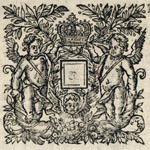 |
Kislak 844
England and Wales. Sovereign (1685-1688: James
II), By the King, a Proclamation for the More Effectual Reducing
and Suppressing of Pirates and Privateers in America. London: Printed by
Charles Bill, Henry Hills, and Thomas Newcomb, [1688].
Pirates are a threat to legal trade and to national borders and domains.
Their autonomy and freedom from national loyalty threatens the sovereignty
of the state. Historically, the ineffectiveness of laws intended to
restrict him, elicited repeated denunciation of their criminality.
Page Turner - PDF (1.39
KB) - Bibliographic
Information |
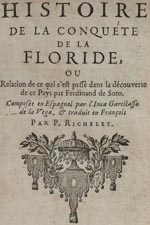
|
Kislak 627
Vega, Garcilaso de la, 1539-1616.
[Florida del Inca. French] Histoire de la Conquete de la Floride. Lille: Jean Musier, 1711.
Garcilaso de la Vega, more commonly known as "El Inca," was the son of Spanish conquistador Sebastián Garcilaso de la Vega y Vargas and an Inca princess, Isabel Suárez Chimpu Ocllo. Garcilaso was educated in Spain and became an author in the European sense, employing the technology of print and the discipline of classical history in order to publish histories of the Spanish and the Incas. This work contains the chronicles of de Sotos's expedition according to information Garcilaso gathered during various years, and defends the legitimacy of imposing the Spanish sovereignty in conquered territories and submit them to Christian jurisdiction. It was first published in Lisbon in 1605, becoming better known as the La Florida del Inca. This is the first French edition.
Page Turner, (Two Volumes) - Bibliographic
Information |
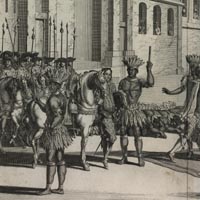
|
Kislak 222
Solís, Antonio de, 1610-1686. The
History of the Conquest of Mexico by the Spaniards / done into English
from the
Original Spanish of Don Antonio de Solis, London: Printed for T. Woodward
... and J. Hooke ... and J. Peele ..., 1724.
Antonio de Solís (1610-1686) served Charles II as the official
historian for the Indies. In this capacity he produced this monumental
work. Removed by more than 150 years from the events, Solís relied
heavily on the work of previous chroniclers, such as Lopéz de
Gomara, Bernal Diaz del Castillo, and Cortés himself. With its
artful writing style, his book was immediately successful, bringing new
attention to Cortés and a heroic view of the Conquest.
Page Turner - PDF (336.97
MB) - Bibliographic Information
|
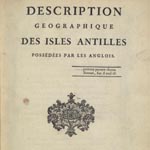
|
Kislak 288
Bellin, Jacques Nicolas, 1703-1772. Description Geographique des Isles Antilles. Paris: Didot, 1758.
The book includes thirteen maps; eight of these are folding and nine additional engraved vignettes.
Page Turner - Bibliographic
Information |
![[Account of the expedition to the West Indies, against Martinico. French]](guade.jpg)
|
Kislak 804
Gardiner, Richard, 1723-1781.
[Account of the Expedition to the West Indies, Against Martinico. French] Relation de l'Expedition…Contre la Martiniques…en 1759. Birmingham [England], [London]: Jean Baskerville, 1762.
With: An account of the expedition to the West Indies, against Martinico. Birmingham: John Baskerville for G. Steidel, 1762.
Gardiner commanded a detachment of Marines at St Pierre, Martinique, and again at the siege of Guadeloupe, publishing this account on his return. The British joint task force was repulsed at Martinique in January, 1759, but took Guadeloupe after a protracted campaign lasting from February to April of that year.
Page Turner - Bibliographic
Information |
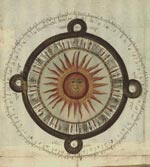 |
Kislak 495
León y Gama, Antonio de, An Historical
and Chronological Description of Two Stones Found Under Ground, in
the Great Square of the City of Mexico, in the Years 1790. Mexico
City: Felipe de Zúniga y Ontiveros, 1792.
Antonio León y Gama, an astronomer sometimes considered the
first Mexican archaeologist, provided the first European account of
Aztec archaeology.
His description of the discovery of the "two stones -- the Coatlicue
and Sun Stone (a massive sacrificial stone and calendar) emphasized
the sophistication and high scientific and artistic achievements of
the Aztecs, responding to and quickening the stirring of Mexican nationalism.
Page Turner - PDF (72.14 KB) - Bibliographic
Information |
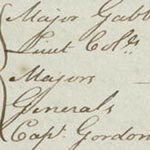 |
Kislak 818
Great Britain. Army. Regiment of Foot, 66th (Berkshire). AM Orderly Book of the 66th (Berkshire) Regiment of Foot, Stationed in Haiti. Port-au-Prince, and Elsewhere. February 16–October 10, 1796.
Written at headquarters during the English expedition against the French in the West Indies. There is some evidence to suggest that the volume is written in the hand of the British commander-in-chief, General Sir Ralph Albercromby.
The renewal of war between Britain and France in 1793 was a continuation of a century-long conflict between these two aggressive imperial powers. During 1794 the British seized several of the smaller French islands in the Caribbean, but at an extremely heavy cost in terms of troops dying of yellow fever. In 1801, the peace of Amiens ended the war between France and Britain.
Page Turner - Bibliographic
Information |
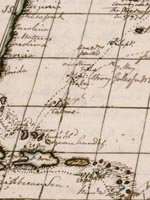 |
Kislak 387
Perry, William, Sea Journals, 1797.
Journals of two voyages, the first: "Journal of a voyage in the
ship Jamaica, William Sherry, from Montego Bay bound to London (July
18-Oct. 15, 1797)." The second with caption: "Journal of
a voyage from Jamaica to England in the Minerva, Rob Hardy, Mast. of
Bristol." First journal includes 7 sketches of coastlines, three
colored tables of signals, three lists of signals, and a "List of
the convoy for England under his Majesty's Ship Sheerness, Capt.
Cornwallis ..." with colored folded map of the Atlantic sea lanes
tipped in.
Page Turner -
PDF (44.51
MB) - Bibliographic
Information |
 |
Kislak 492
Collection of Drawings Copied from the Original
Figures...Discovered in the...Pueblo of Palenque. [Palenque,
Mexico: 1787]
In 1787, the military governor of Guatemala sent soldier Antonio
del Río to excavate a Mayan ruin near Palenque, marking the
dawn of scientific archaeology in the Americas. Del Río and
his men spent five weeks clearing the site and studying, drawing,
and exploring. Del Río recounted the work in a remarkable
report that was illustrated with thirty drawings made by Ricardo
Almendáriz. Del Río's manuscript has been preserved
in Madrid, but the drawings were only recently found in a private
European collection.
Page Turner -
PDF (19.57
MB) |
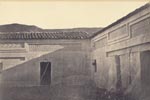

|
Works by Charnay, Désiré,
1828-1915.
Kislak 529
Ruines
du et México and Méxicans. 1862-1863. [Ruins of Mexico and Mexican Types; Album of Fifty-Two Photographs: Forty-Two of Mexican Ruins by Charnay, and Ten “Tipos Mexicanos” by Julio Michaud.]
Page
Turner - PDF (15.08
MB) - Bibliographic
Information
Kislak 547
Les Anciennes Villes du Nouveau Monde: Voyages d’Explorations au Mexique et dans l’Amérique Centrale; Ouvrage Contenant 214 Gravures et 19 Cartes ou Plans. [Ancient Cities of the New World], Paris: Librarie Hachette et cie, 1885.
Page
Turner - PDF (245.79 MB) - Bibliographic
Information
The Charnay images have handwritten captions in French; Michaud images have printed captions in Spanish.
The portfolio of albumen prints of the ruins at Mitla, Izamal, Chichén Itzá, and Uxmal and book are the result of the first systematic photographic expedition to Mesoamerican ruins made by the French photographer and explorer Désiré Charnay during two seasons of fieldwork in 1859 and 1860. Charnay's work was instrumental in attracting serious scholarly interest in pre-conquest México, thus setting the stage for later intensive archaeological studies of Mesoamerican civilization. Charnay's systematic approach to photographing ruins and his triumph over tremendous logistical problems places him in the grand tradition of 19th century expeditionary photography.
|
 |
Kislak 903
Jefferson, Thomas, 1743-1826. Thomas Jefferson Letter, 1813 Nov. 30
Topics include sheep industry and the manufacture of cloth in the United States as opposed to England ("our progress in manufactures is far beyond the calculations of the most sanguine . . . This revolution in our domestic economy was well worth a war"); the war on land in Canada; the alliance of Indians and the British; the naval war and Perry's victory on Lake Erie; and views on the emancipation of South America.
Page Turner - PDF (881.70 KB) - Bibliographic Information |
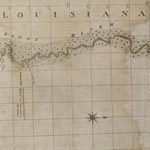 |
Kislak 657
Ellicott, Andrew, 1754-1820. The Journal of Andrew Ellicott… During Part of the Year 1796, the Years 1797, 1798, 1799, and Part of the Year 1800 for Determining the Boundary Between the United States and the Possessions of His Catholic Majesty in America. Philadelphia: William Fry, 1814.
George Washington appointed Ellicott commissioner to determine the boundary between the United States and Spanish Florida. His work required four years of travel through the forests, swamps and bayous of the Mississippi Valley and West Florida. The fourteen maps and plans that resulted are the earliest American account of this region and undoubtedly contributed to the growing interest of the United States government to acquire the territory from Spain, which it did with the signing of the Adams-Onis Treaty in February 1819
Page Turner - PDF (162.41 MB) - Bibliographic Information |
 Kislak 585. Rivera, Diego, 1886-1957. [Creation] [graphic] / Diego Rivera. [1931] Kislak 585. Rivera, Diego, 1886-1957. [Creation] [graphic] / Diego Rivera. [1931]
Page Turner - PDF - Bibliographic Information

Kislak 586. Rivera, Diego, 1886-1957.
[Trials of the hero-twins] DR [monogram].
[1931]
Page Turner - PDF - Bibliographic Information
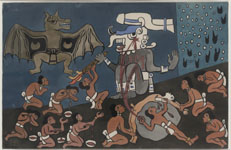 Kislak 587. Rivera, Diego, 1886-1957. [Human sacrifice before Tohil] [graphic] / D Rivera [partial monogram]. [1931] Kislak 587. Rivera, Diego, 1886-1957. [Human sacrifice before Tohil] [graphic] / D Rivera [partial monogram]. [1931]
Page Turner - PDF - Bibliographic Information
|
RIVERA, DIEGO (1886-1957)
Illustrations for the Popol Vuh, 1930-1931
Diego Rivera’s work of a series of illustrations for a translation of the Popol Vuh by North American writer John Weatherwax. The Popol Vuh or council book recounts the ideas and traditions, origins and dynastic chronology up to the year 1550 of the ancient Quiché Maya. Beginning as oral tradition, the Popol Vuh was sent down in hieroglyphic form, then into an “alphabetic substitute” before being transcribed and translated into Spanish by the Dominican friar Francisco Ximénez in the 18th century.
Relying on his considerable knowledge of pre-Columbian codices and sculpture, Rivera brilliantly conjures up the epic narrative for the “listener”/viewer. His imagery, like the language of the Popol Vuh itself, “paints in brightest colors the life and thoughts of a great people.” It provides stunning access to a pre-Cortés civilization irrevocably changed by historical events. from the creation story, the hero-twins’ confrontation with the Lords of the Underworld, to worship of a god by “our [Quiché Maya] forefathers,” according to Weatherwax’s translation.
|
Other Kislak Materials:
|